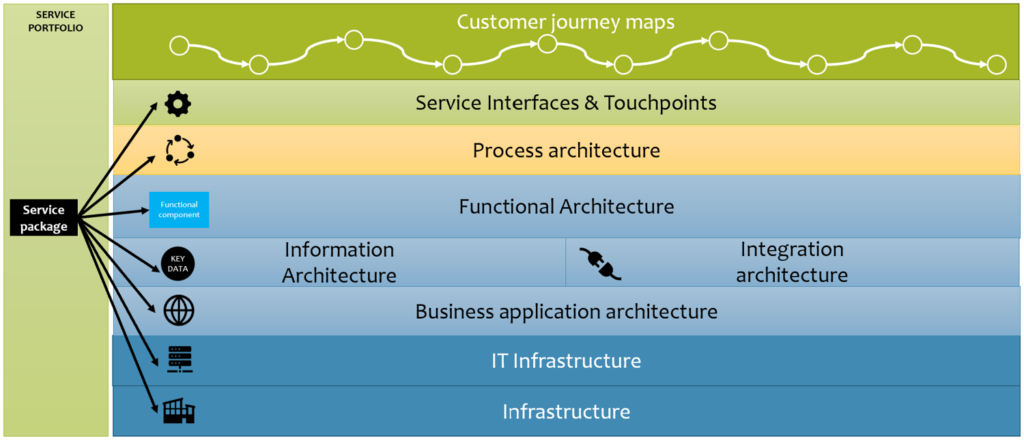Business Impact Analysis (BIA) loves Configuration Management
Gartner defines Business Impact Analysis as “the process of determining the criticality of business activities and associated resource requirements to ensure operational resilience and continuity of operations during and after a business disruption. The BIA quantifies the impacts of disruptions on service delivery, risks to service delivery, and recovery time objectives (RTOs) and recovery point objectives (RPOs). These recovery requirements are then used to develop strategies, solutions and plans.”
Where to start?
In order to perform a Business Impact Analysis for business activities, you first need to understand the components of the business activity (one or more services usually).
- Customer journeys and associated Service Interfaces (Phone, web pages, APIs, SMS, etc) – “How do our customers and other users participate in the business activities”
- Underlying Services and contracts – “What are those service touchpoints made of”
- Processes and the organization around them – “What entities are processing the information and how”
- Functional architecture, information architecture, and integration architecture – “What functional components are we using from which business applications and what information are we processing and how is it moving between the functional components and systems”
- Business applications – “What information systems are we using in our processes”
- IT Infrastructure – “What are the components of the information systems we are using”
- Infrastructure (physical world) – “Where are all the components located in the physical world and how are they connected”

Why do you need all this information?
The reason is that in your Business Impact Analysis, you need to be able to describe the business impact of an adverse situation such as
- Pandemic or other reason why your staff can not work from your offices or other physical locations
- Fire, water damage, or other serious physical malady at one or more of your locations
- Bankruptcy of one of your suppliers
- Loss of access to a business application (e.g. Salesforce, Dynamix, or book keeping software)
- <any other event your Risk Management has identified as a potential threat to your service>
So, you will need to understand the components in order to assess the impact down stream from the component. In other words, you need to understand the components to answers questions such as
- “What business operations will cease if we lose access to <critical software>, and what is the loss per <a period time time>.
- “What business operations are impacted by a loss of connectivity in office A”
- “What is the business impact of a recently proposed new EU regulation”
If you are starting from nothing, this sounds like a daunting task, doesn’t it?
Where the organization should have started
Organizations need to have a clearly defined Operating Model for (IT) Service Management describing the tools, organization, processes, and maintained information. Other term for the same is that organizations need to have Service Management System (SMS) defined.
One particularly useful piece of that puzzle is Configuration Management. It describes the who, what, where, and how the Configuration Management Database (CMDB) is maintained and in what format (data model). That should answer most of the questions we had in our “Where to start” section.
Having an up-to-date information of the components of your service and the dependencies between the components and other services is crucial for being able to create an accurate Business Impact Analysis. Configuration Management makes sure you have that information available, and not only for that purpose.
Contact us if your organization requires help in defining
- the Operating Model for Service Management (or Service Management System)
- the Business Impact Analysis
- the Business Continuity and Disaster Recovery Plans
- the Configuration Management, Service Asset and Configuration Management, or CMDB
Need to know more?
Creative Service Management -handbook serves as an aid and information source for people working with service development, leadership and management. Order your copy in JustinShop.
If you need training on CMDB, Service Catalog topics or want to know the secrets of IT4IT, click here and familiarize yourself with Justin’s training offering
Checkout Creative Service Management videos on our Youtube-channel
- Intelligent Data Processing, introduces the secrets of functional architecture. The functional architecture enables the intelligent design and description of internal management systems, their functionalities, and the information processed in them.
- CMDB A-B-C: what a CMDB is and what benefits its use will bring to service organizations. In addition, the video will list the 4 most important things to consider when implementing CMDB and configuration management. English subtitles available!
If you’re not already following us on LinkedIn, you can easily fix it here: https://www.linkedin.com/company/justin-group-oy/
Julkaistu 23.03.2022
